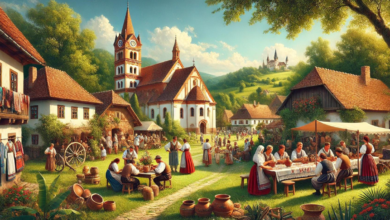Renowned for its famous sites, rich legacy, and varied landscapes, France has always been a desirable tourism destination. But people travel differently as the world changes. New trends over the next ten years will define French tourism going forward. From environmental concerns to digital innovations, the nation is changing to satisfy contemporary visitors.
The eSIM is one major breakthrough simplifying travel. This digital SIM card lets visitors remain connected without having to purchase a local SIM or worry about costly roaming charges. eSIM technology, such as eSIM France, offers consistent mobile access, therefore improving the trip experience whether one is negotiating the streets of Paris or touring the countryside of Provence.
We shall explore the main developments that will characterize tourism in France in the next years in this post. These comprise sustainable travel, digital advances, tailored experiences, and technological preservation of culture.
The Rise of Sustainable Tourism in France
Sustainable travel is starting to take front stage for tourists as more people realize their influence on the surroundings. With an eye toward safeguarding its natural and cultural legacy, France is setting the standard for environmentally sustainable travel choices.
One of main areas of concentration is green mobility. Investing on its high-speed rail system (TGV), the French government hopes to make train travel more enticing than domestic flying. Trains are a pleasant, picturesque means of seeing the nation and emit significantly less pollutants. For instance, riding the TGV from Paris to Nice lets visitors enjoy breathtaking views of the French countryside while cutting their carbon footprint.
By building more charging stations all throughout the nation, France is also pushing the adoption of electric cars. This makes road travels over areas like the Loire Valley or Normandy more environmentally friendly. To further cut dependency on cars, several cities—including Paris—have added pedestrian-friendly areas and bike-sharing schemes.
Another expanding trend are environmentally friendly lodging options. Many hotels and resorts are implementing sustainable practices include cutting waste, employing renewable energy, and providing locally grown food. Eco-certified hotels abound now, ranging from solar-powered guesthouses in Provence to treehouse stays in the Dordogne area.
At last, the government is acting to control over-tourism at major sites such the Côte d’Azur and Mont Saint-Michel. France is making sure that its attractions stay lovely and easily accessible for next generations by controlling visitor numbers and supporting less-known areas.
Digital Tourism and Technological Innovations
People’s perspective of France is changing thanks to technology. Travel is becoming more easy and engaging thanks to digital tools, which also improve the way visitors discover the nation.
Travel attractions are featuring increasingly virtual and augmented reality (VR and AR). For example, guests of the Palace of Versailles can experience its original splendor using VR headsets. AR apps also let visitors to historically significant monuments like the Roman amphitheater in Arles come to life with meticulous reconstructions.
Still another big development are contactless services. From app-based transportation tickets to mobile purchases, France is helping tourists get about without carrying cash or paper tickets. Nowadays, attractions like the Eiffel Tower provide digital ticketing so that guests may enjoy a more seamless experience by skipping large queues.
People’s navigation of rural and metropolitan places is also evolving with technology. Apps give real-time data about local events, public transit, and restaurant recommendations. From a family-owned vineyard in Bordeaux to a little café in Montmartre, travellers can locate hidden treasures using their cellphones.
Although eSIM technology was discussed already, it is necessary to underline once more how crucial it is for visitors using these digital tools. Travelers may quickly access maps, language translators, and travel apps using an eSIM without worrying about inconsistent Wi-Fi or costly roaming charges. This makes visiting France’s metropolitan centers and outlying towns far more fun.
The Personalization of Travel Experiences
Personalization is one of the main trends in upcoming travel. Travelers no longer seek for a one-size-fits-all solution. Rather, they look for distinctive, customized experiences fit for their tastes and hobbies.
Customized trip planning is being facilitated by AI-powered tools for travelers. Travel apps, for instance, can offer plans depending on a person’s budget, preferred activities, or past travels. A history buff might be sent to mediaeval cities like Carcassonne or the D-Day beaches of Normandy. A cuisine enthusiast might meanwhile get recommendations for the top patisseries in Paris or Burgundy wine tastings.
This tendency is also motivating tourists to investigate off-the-travel path locations. Though Paris is still a favorite, more visitors are exploring less well-known areas like Alsace, noted for its fairy-tale villages and vineyards, or Occitanie, known for its castles and countryside. Tools for personalizing help one find these hidden treasures more quickly.
This inclination is also helping France’s gastronomic scene. Travelers may now schedule tailored dining and drinking experiences include private cooking lessons in Lyon, truffle-hunting in Provence, or Champagne cellars. These close-knit, practical exercises let visitors engage more profoundly in French culture.
Cultural Preservation Through Modern Tech
Millions of people travel to France annually mostly for its rich history and culture. Using technology to save historical sites and provide interesting tourist experiences, the nation is safeguarding and distributing its legacy.
Cultural sites are being preserved in great part by digital archiving. Experts can guarantee the history of landmarks like Notre Dame or Mont Saint-Michel is safe, even in the face of aging or natural events by building thorough digital archives of them. These archives let next generations research and value these sites as well.
AR and VR are giving cultural events fresh angles. AR-enhanced tours of historical sites, for instance, let visitors experience how locations appeared in many eras. This technology brings history to life, hence trips to sites like the Pont du Gard or the Château de Chambord become more engaging and unforgettable.
Still another invention are hybrid travel experiences. Although nothing can substitute personally visiting France’s sites, virtual tours provide access to those unable of travel. Nowadays, many museums—including the Louvre—offer 360-degree virtual tours and online displays so that people all over may study French art and history from their homes.
Summary
People’s travel habits are evolving; France is leading the way with eco-friendly methods, digital tools, and individualized experiences. Whether they are seeing the busy streets of Paris or the serene settings of Provence, innovations like eSIMs guarantee that travellers can remain connected and maximize their time.
France honors its legacy while looking ahead as it implements fresh technology and policies. Travelers that embrace these trends will be able to enjoy a more practical, immersive, and environmentally friendly approach to see all this amazing nation has to offer.
Traveling in France over the next ten years looks to be an interesting adventure. Whether your journey is first-time or seasoned, these improvements will make it unforgettable.




